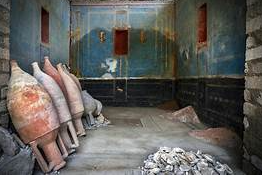Archaeologists discover a sacred room with blue-painted walls, revealing the high status of its former owners.
A rare and expensive blue-painted shrine has been unearthed in Pompeii, Italy, nearly 2,000 years after it was buried by the eruption of Mount Vesuvius. The sacred room, with its distinctive blue walls, offers a unique glimpse into the wealth and status of its former occupants, according to Gabriel Zuchtriegel, the director of the archaeological site.
The color blue was an expensive choice in ancient Rome, as it was difficult to produce. As Zuchtriegel explained during a tour of the newly excavated area, blue pigment was rare and costly, making it a symbol of wealth. Those who chose to decorate their rooms with blue were making a statement of their financial capacity, showcasing their ability to afford what was not accessible to everyone in Pompeii.
The shrine’s discovery has captivated archaeologists, as such a find is considered unusual for the city. Pompeii is known for its well-preserved ruins, which offer insights into daily life in the Roman Empire, but the use of blue pigment in this context is especially rare. This discovery helps shed light on the social dynamics and the elite’s access to luxury items in Pompeii before the catastrophic eruption.
The shrine, along with its striking blue walls, is a testament to the artistic and cultural achievements of the time. It also highlights the craftsmanship involved in producing pigments, a process that required significant resources. The discovery of the shrine adds to the growing body of knowledge about Pompeii and its inhabitants, particularly their use of color and art in domestic spaces.
Experts are excited about the potential of this new find to provide further understanding of Pompeii’s artistic traditions. The blue walls are not only a visual treat but also a powerful symbol of the economic and social hierarchies in ancient Roman society. The shrine’s discovery will likely lead to further studies and potentially more excavations in the area to uncover additional artifacts.
Zuchtriegel and his team continue to work on preserving the site, ensuring that these rare and significant finds are properly studied and protected for future generations. The blue shrine stands as a reminder of Pompeii’s vibrant history, offering a glimpse into the past that was almost lost forever.
This discovery has sparked renewed interest in the ongoing excavations at Pompeii, which continue to reveal new insights into Roman life and the rich history of the ancient city that was once a thriving hub of culture and commerce.

